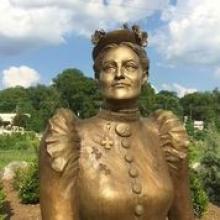You are here
Jane Wilkes Statue
In 2014, a small group of people gathered for the unveiling of a statue of Jane Renwick Smedberg Wilkes. Those attending the ceremony on the Little Sugar Creek Greenway knew they were there to honor her contribution in establishing Charlotte’s first two hospitals. Still, people ask, “Who was this woman?” To historian Dan Morrill, she was among the most important women in Charlotte history, second only to Bonnie Cone in her influence on the city. (Dan Morrill, Historic Charlotte (Charlotte, NC: Historic Charlotte, Inc., 2001) p.85)
The Wilkes Family in CharlotteJeanie and Jack were full of hope and optimism for the future they saw before them, but they could not have imagined the tumultuous times ahead for themselves and the nation. The couple arrived in Charlotte in May of 1854 and made their home, first in St. Catherine’s and later in Charlotte. Jack Wilkes worked hard to make a success of the milling operations and other mining ventures. However, he purchased the Mecklenburg Iron Works in 1856 and also started the Mecklenburg Flour Mill and barrel-making operation. The iron works remained in operation until 1968. The couple raised their family and were very involved in St. Peter’s Episcopal Church where Jack Wilkes served as a vestryman throughout his life.
When the Civil War broke out, the flour operations ceased and Jack sold or leased the iron works to the Confederate Navy, which used it as the Confederate Naval Yard. Jack Wilkes joined his brother Edmund “Em” Wilkes in constructing a railroad from Danville to Greensboro for the Confederacy. He also served in the local militia and was made Captain. In her spare time, Jeanie Wilkes volunteered at a local hospital, but most of her time was taken up with their five children, two of whom were born during the war. (There were nine children in all, but only five lived to enjoy adulthood.)
Theirs was a marriage of equal partnership and devotion. After the war, Jack Wilkes became active in obtaining a charter for the First National Bank of Charlotte, opened a woolen mill and reclaimed the iron works. His endeavors in the woolen mill failed and the money loaned to him by the Coates Brothers of Salisbury eventually led to a lawsuit. However, the Mecklenburg Iron Works remained the constant source of income for the family. Despite their financial hardships and the deaths of several of their children, the Wilkes became active participants in the Charlotte community and contributed to social and cultural improvements.
In the 1870s, Jeanie Wilkes devoted her time to raising money for two hospitals, one for whites which became St. Peter’s Hospital and one for blacks, Good Samaritan. She served on fundraising committees and served on the boards of both hospitals. Much of Jeanie’s time involved writing church ladies’ societies, clergymen, family members, and doctors for their assistance, financial and otherwise for these two projects.
